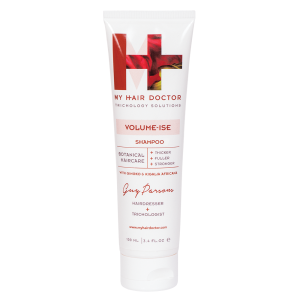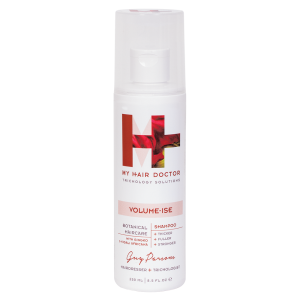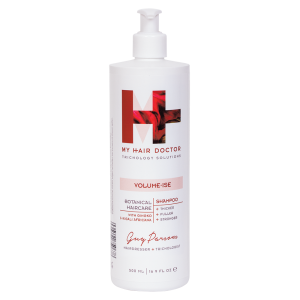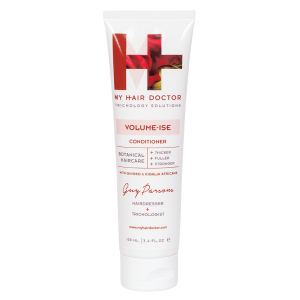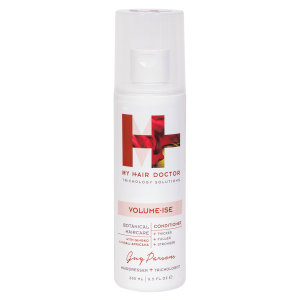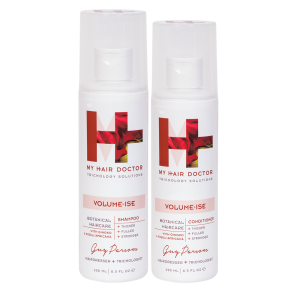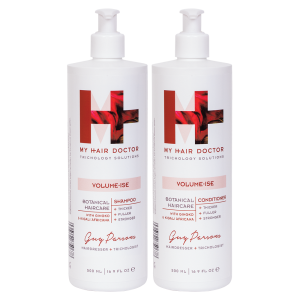Hair Science, Hair Loss Men
MALE PATTERN BALDNESS
Male-pattern hair loss (MPHL), also known as androgenic alopecia and male pattern baldness, is hair loss that occurs due to an underlying susceptibility of hair follicles to shrinkage due to the influence of androgenic hormones. Male-pattern hair loss is the most common cause of hair loss and will affect up to 70% of men and 40% of women at some point in their lifetimes. Men typically present with progressive hair loss at the temples and towards the crown, whereas women typically present with diffuse hair loss over the top of their scalps. Both genetic and environmental factors play a role, and many causes of malepattern hair loss remain unknown. Male pattern baldness, is the most common type of hair loss in men. According to the U.S. National Library of Medicine (NLM), more than 50 percent of all men over the age of 50 will be affected by male pattern baldness to some extent.
What Causes Male Pattern Baldness?
One cause of male pattern baldness is genetics, or having a family history of baldness. Research has found that male pattern baldness is associated with male sex hormones called androgens. The androgens have many functions including regulating hair growth. Each hair on your head has a growth cycle. With male pattern baldness, this growth cycle begins to weaken and the hair follicle shrinks, producing shorter and finer strands of hair. Eventually, the growth cycle for each hair ends and no new hair grows in its place.
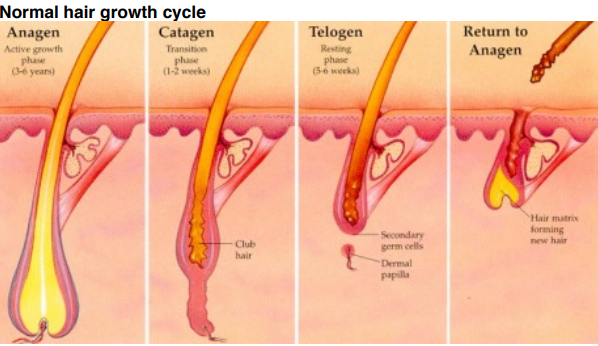 Inherited male pattern baldness usually has no medical ill effects. However, sometimes baldness has more serious causes, such as certain cancers, medications, thyroid conditions, and anabolic steroids. See your doctor/trichologist if hair loss occurs after taking new medications or when it’s accompanied by other health complaints. Doctors use the pattern of hair loss to diagnose male pattern baldness. They may perform a medical history and exam to rule out certain health conditions as the cause, such as fungal conditions of the scalp or nutritional disorders. Health conditions may be a cause of baldness when a rash, redness, pain, peeling of the scalp, hair breakage, patchy hair loss, or anunusual pattern of hair loss accompanies the hair loss. A skin biopsy and blood tests also may be necessary to diagnose disorders responsible for the hair loss.
Inherited male pattern baldness usually has no medical ill effects. However, sometimes baldness has more serious causes, such as certain cancers, medications, thyroid conditions, and anabolic steroids. See your doctor/trichologist if hair loss occurs after taking new medications or when it’s accompanied by other health complaints. Doctors use the pattern of hair loss to diagnose male pattern baldness. They may perform a medical history and exam to rule out certain health conditions as the cause, such as fungal conditions of the scalp or nutritional disorders. Health conditions may be a cause of baldness when a rash, redness, pain, peeling of the scalp, hair breakage, patchy hair loss, or anunusual pattern of hair loss accompanies the hair loss. A skin biopsy and blood tests also may be necessary to diagnose disorders responsible for the hair loss.
Signs and symptoms
Classic male-pattern hair loss begins above the temples and vertex, or calvaria, of the scalp. As it progresses, a rim of hair at the sides and rear of the head remains. This has been referred to as a ‘Hippocratic wreath’, and rarely progresses to complete baldness The Hamilton-Norwood scale has been developed to grade androgenic alopecia in males. Female androgenic alopecia is known colloquially as “female pattern baldness”, although its characteristics can also occur in males. It more often causes diffuse thinning without hairline recession; similar to its male counterpart, female androgenic alopecia rarely leads to total hair loss. The Ludwig scale grades severity of androgenic alopecia in females.
 Causes
Causes
Testosterone exists in your body in different forms. There’s “free” testosterone that isn’t bound to proteins in your body. This is the form of testosterone most available to act within the body. Testosterone can also be bound to albumin, a protein in the blood. Most testosterone is bound to sex hormone-binding globulin (SHBG) protein and isn’t active. If you have a low level of SHBG, you may have a high level of free testosterone in your bloodstream. Dihydrotestosterone (DHT) is made from testosterone by an enzyme. DHT is five times more potent than testosterone. DHT is primarily used by the body in the prostate, skin, and hair follicles.
DHT: The hormone behind hair loss
Dihydrotestosterone (DHT) is made from testosterone by an enzyme called 5-alpha reductase.
It can also be made from DHEA, a hormone more common in women. DHT is found in skin, hair follicles, and the prostate. The actions of DHT and the sensitivity of hair follicles to DHT is what causes hair loss. DHT also acts in the prostate. Without DHT, the prostate doesn’t develop normally. With too much DHT, a man can develop benign prostrate hypertropy, also known as an enlarged prostate.
It’s not the amount of testosterone or DHT that causes baldness; it’s the sensitivity of your hair follicles. That sensitivity is determined by genetics. The AR gene makes the receptor on hair follicles that interact with testosterone and DHT. If your receptors are particularly sensitive, they are more easily triggered by even small amounts of DHT, and hair loss occurs more easily as a result. Other genes may also play a part. Age, stress, and other factors can influence whether you experience hair loss. But genes play a significant role, and men who have close male relatives with MPB have a much higher risk of developing MPB themselves. Several methods of treating MPB and FPHL involve interfering with testosterone and DHT’s actions. Finasteride (Propecia) is a drug that inhibits the 5-alpha reductase enzyme that converts testosterone to DHT. It’s dangerous to use in women who may become pregnant, and there may be sexual side effects of this drug on both men and women. Another 5-alpha reductase inhibitor called dutasteride (Avodart) is currently being looked at as a potential treatment for MPB. It’s currently on the market for treatment of an enlarged prostate.
Other treatment options that don’t involve testosterone or DHT include:
- Minoxidil (Rogaine)
- Ketoconazole
- Laser treatment
- Surgical hair follicle transplant
Transgenic studies have shown that growth and dormancy of hair follicles are related to the activity of insulin-like growth factor (IGF) at the dermal papillae, which is affected by DHT. Androgens are important in male sexual development around birth and at puberty. They regulate sebaceous glands, apocrine hair growth, and libido. With increasing age, androgens stimulate hair growth on the face, but suppress it at the temples and scalp vertex, a condition that has been referred to as the ‘androgen paradox’ Men with androgenic alopecia typically have higher 5-alpha-reductase, lower total testosterone, higher unbound/free testosterone, and higher free androgens, including DHT. 5-alpha-reductase converts free testosterone into DHT, and is highest in the scalp and prostate gland. DHT is most commonly formed at the tissue level by 5α-reduction of testosterone. The genetic corollary that codes for this enzyme has been discovered. Prolactin has also been suggested to have different effects on the hair follicle across gender.
Genetics
Balding is multifactorial, with several lines of evidence suggesting it most likely functions by a genetic predisposition (diathesis). Since androgens and androgen receptors (AR) are the initiating cause of androgenic alopecia, their genetic corollaries are a subject of much research.
Age
Androgens stimulate growth of facial hair, but can suppress scalp hair, a condition that has been called the ‘androgen paradox’.
A number of hormonal changes occur with aging:
1. Decrease in testosterone
2. Decrease in serum DHT and 5-alpha reductase
3. Decrease 3AAG, a peripheral marker of DHT metabolism
4. Increase in SHBG
5. Decrease in androgen receptors,
5-alpha reductase type I and II activity, and aromatase in the scalp
This decrease in androgens and androgen receptors, and the increase in SHBG are opposite the increase in androgenic alopecia with aging. This is not intuitive, as testosterone and its peripheral metabolite, DHT, accelerate hair loss, and SHBG is thought to be protective. The ratio of T/SHBG, DHT/SHBG decreases by as much as 80% by age 80, in numeric parallel to hair loss, and approximates
Diagnosis
The diagnosis of androgenic alopecia can be usually established based on clinical presentation in men. In women, the diagnosis usually requires more complex diagnostic evaluation. Further evaluation of the differential requires exclusion of other causes of hair loss, and assessing for the typical progressive hair loss pattern of androgenic alopecia. Trichoscopy can be used for further evaluation. Biopsy may be needed to exclude other causes of hair loss, and histology would demonstrate perifollicular fibrosis.
Management
Medication
Hair loss can be slowed or reversed in its early stages with medication. Medications to treat male-pattern hair loss include minoxidil and finasteride.
Androgen-dependent
Finasteride is a medication of the 5α-reductase inhibitors (5-ARIs) class. By inhibiting type II 5-ARI, finasteride prevents the conversion of testosterone to dihydrotestosterone in various tissues including the scalp. Increased hair on the scalp can be seen within three months of starting finasteride treatment and longer-term studies have demonstrated increased hair on the scalp at 24 and 48 months with continued use. Treatment with finasteride more effectively treats male-pattern hair loss at the vertex than male-pattern hair loss at the front of the head and temples. Dutasteride is a medication in the same class as finasteride but inhibits both type I and type II 5-alpha reductase. Dutasteride is approved for the treatment of male-pattern hair loss in Korea, but not in the United Kingdom. However, it is commonly used off-label to treat malepattern hair loss
Androgen-independent
Minoxidil is a growth stimulant that stimulates already-damaged hair follicles to produce normal hair. Minoxidil does not, however, provide any protection to the follicles from further DHT damage, and when a follicle eventually becomes completely destroyed by DHT, minoxidil will no longer be able to have any more regrowth effects on that follicle. Other treatment options include tretinoin combined with minoxidil, ketoconazole shampoo, spironolactone, alfatradiol, and topilutamide (fluridil).
Surgical Procedures
More advanced cases may be resistant or unresponsive to medical therapy, and require hair transplantation. Naturally occurring units of one to four hairs, called follicular units, are excised and moved to areas of hair restoration. These follicular units are surgically implanted in the scalp in close proximity and in large numbers. The grafts are obtained from either follicular unit transplantation (FUT) or follicular unit extraction (FUE). In the former, a strip of skin with follicular units is extracted and dissected into individual follicular unit grafts. The surgeon then implants the grafts into small incisions, called recipient sites. Specialized scalp tattoos can also mimic the appearance of a short, buzzed haircut.
Alternative Therapies
Many people use unproven treatments. There is no evidence for vitamins, minerals, or other dietary supplements. As of 2008, there is little evidence to support the use of lasers to treat male-pattern hair loss. The same applies to special lights. Dietary supplements are not typically recommended.
Prognosis
Psychological
Androgenic alopecia is typically experienced as a “moderately stressful condition that diminishes body image satisfaction”. However, although most men regard baldness as an unwanted and distressing experience, they usually are able to cope and retain integrity of personality. Although baldness is not as common in women as in men, the psychological effects of hair loss tend to be much greater. Typically, the frontal hairline is preserved, but the density of hair is decreased on all areas of the scalp. Previously, it was believed to be caused by testosterone just as in male baldness, but most women who lose hair have normal testosterone levels.
 Epidemiology
Epidemiology
Female androgenic alopecia has become a growing problem that, according to the American Academy of Dermatology, affects around 30 million women in the United States. Although hair loss in females normally occurs after the age of 50 or even later when it does not follow events like pregnancy, chronic illness, crash diets, and stress among others, it is now occurring at earlier ages with reported cases in women as young as 15 or 16.
Myths
An ancient phenomenon:
Greek philosophers with and without much hair (from left to right: Socrates, Antisthenes, Chrysippus, and Epicurus, fifth to third centuries BC) Many myths are given regarding the possible causes of baldness and its relationship with one’s virility, intelligence, ethnicity, job, social class, wealth, etc. While scepticism may be warranted in many cases due to a lack of scientific validation, some claims may have a degree of underlying truth and are supported by research.
“ You inherit baldness from your mother’s father. ”
A 50% chance exists for a person to share the same X chromosome as his maternal grandfather. Because women have two X chromosomes, they have two copies of the androgen receptor gene, while men only have one. However, a person with a balding father also has a significantly greater chance of experiencing hair loss.
A 50% chance exists for a person to share the same X chromosome as his maternal grandfather. Because women have two X chromosomes, they have two copies of the androgen receptor gene, while men only have one. However, a person with a balding father also has a significantly greater chance of experiencing hair loss.
“ Weight training and other types of physical activity cause baldness. ”
Because it increases testosterone levels, many internet forums have put forward the idea that weight training and other forms of exercise increase hair loss in predisposed individuals. Although scientific studies do support a correlation between exercise and testosterone, no direct study has found a link between exercise and baldness. However, a few have found a relationship between a sedentary lifestyle and baldness, suggesting some exercise is beneficial. The type or quantity of exercise may influence hair loss. Testosterone levels are not a good marker of baldness, and many studies actually show paradoxical low testosterone in balding persons, although research on the implications is limited.
 “ Baldness can be caused by emotional stress, sleep deprivation, etc. ”
“ Baldness can be caused by emotional stress, sleep deprivation, etc. ”
Emotional stress has been shown to accelerate baldness in genetically susceptible individuals. Stress due to sleep deprivation in military recruits lowered testosterone levels, but is not noted to have affected SHBG. Thus, stress due to sleep deprivation in fit males is unlikely to elevate DHT, which causes male pattern baldness. Whether it can cause hair loss by some other mechanism is not clear.
“ Bald men are more ‘virile’ or sexually active than others. ”
Levels of free testosterone are strongly linked to libido and DHT levels, but unless free testosterone is virtually non-existent, levels have not been shown to affect virility. Men with androgenic alopecia are more likely to have a higher baseline of free androgens. However, sexual activity is multifactoral, and androgenic profile is not the only determining factor in baldness. Additionally, because hair loss is progressive and free testosterone declines with age, a male’s hairline may be more indicative of his past than his present disposition.
 “ Frequent ejaculation causes baldness. ”
“ Frequent ejaculation causes baldness. ”
Many misconceptions exist about what can help prevent hair loss, one of these being that lack of sexual activity will automatically prevent hair loss. While a proven direct correlation exists between increased frequency of ejaculation and increased levels of DHT, as shown in a recent study by Harvard Medical School, the study suggests that ejaculation frequency may be a sign, rather than necessarily a cause, of higher DHT levels. Another study shows that although sexual arousal and masturbation-induced orgasm increase testosterone concentration around orgasm, they reduce testosterone concentration on average (especially before abstinence) and because about 5% of testosterone is converted to DHT, ejaculation does not elevate DHT levels. The only published study to test correlation between ejaculation frequency and baldness was probably large enough to detect an association (1390 subjects) and found no correlation, although persons with only vertex androgenetic alopecia had had fewer female sexual partners than those of other androgenetic alopecia categories (such as frontal or both frontal and vertex). One study may not be enough especially in baldness, where there is a complex with age.
Names
Male pattern hair loss is also known as androgenic alopecia, androgenetic alopecia (AGA), alopecia androgenetica and male pattern baldness (MPB
Volume-ise / Hairfood Active Botanicals


GINGKO
Working with Kigalia and Clary as an original blend of 3 plants acting synergistically and allowing scalp toning and limiting hair loss. They act on factors avoiding hair loss including 5-alpha-reductase inhibition, scalp microcirculation improvement and to decrease inflammation contributing to Seborrhoea (oiliness) which can block scalp follicles inhibiting growth.


KIGALIA AFRICANA
Working with Gingko and Clary as an original blend of 3 plants acting synergistically and allowing scalp toning and limiting hair loss . They act on factors avoiding hair loss including 5-alpha-reductase inhibition, scalp microcirculation improvement and to decrease inflammation contributing to Seborrhoea (oiliness) which can block scalp follicles inhibiting growth.


CLARY
Working with Kigalia and Gingko as an original blend of 3 plants acting synergistically and allowing scalp toning and limiting hair-loss. They act on factors avoiding hair loss including 5-alpha-reductase inhibition, scalp microcirculation improvement and to decrease inflammation contributing to Seborrhoea (oiliness) which can block scalp follicles inhibiting growth.



